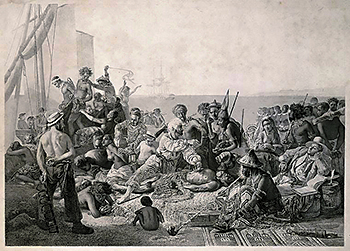
The antislavery tract written by the former slave Olaudah Equiano provides a chilling account of the "middle passage," the shipboard experience of transit from Africa to the Americas. Weeks of being chained below deck, trading along the coast, storms at sea, meager food and water, disease, beatings, rebellion, and, for many, death were part of the experience.
An important aspect of the way in which the slave trade grew in the hands of the Spanish and Portuguese initially and later the English and other northern European and American nations was the ocean itself. Turn on the Major Ocean Currents layer and examine the relation between the ocean currents and the pattern of colonialization along with the growth of the slave trade.
Virtually all of the accounts of the middle passage - even those from slave merchants and captains of slave vessels - speak in one form or another about the horror of the experience. Many of these experiences are captured in the documents and images below. Open and print a copy of the Middle Passage concept map. As you read and study the documents make brief notes related to each in the corresponding section of the the map.
1) The survival rate of slaves making the middle passage
reflected the conditions in which they traveled aboard ship.
Turn on the Slave Destinations layer in the Slave Trade map. Notice that the pop
up windows for the points of departure in Africa and the
destinations in the Americas contain detailed information about
numbers leaving and arriving as well as survival rates. Describe
changes over time of the American destinations and the slave
survival rates.
2) Turn on the Major Ocean Currents
layer and describe the role the currents played in shaping the
slave trade for ships originating from European ports -
particularly from Spain and Portugal, the two most significant
trading countries.
2) The Treaty of Tordesillas was ratified in
1494 dividing the new world between the Spanish and the
Portuguese. Do some research into the provisions of the treaty.
Turn on the Treaty of Tordesillas layer.
Politically, how does the treaty help explain the shift in the
center of Portuguese trade in slaves along the African coast
from the Guinea coast south to modern day Congo and Angola? (Hint:
Open the Africa - 1830 layer and examine the
place names along the Slave coast and then further south along
the coast of West Central Africa.) How do the geographic facts
of the ocean currents explored above help explain this shift?
3) As the instructions from Humphry
Morice suggest, repeated bartering for slaves
in exchange for gold was common along the African coast. Examine
the painting Scene
on the Coast of Africa closely. The details
reveal much of the slaves' experiences as they were traded one
owner to another. Identify as many of these details as you can
and explain the significance of each.
4) Compare the anti-slavery arguments of Alexander
Falconbridge and William
Wilberforce. What is the strongest argument
against slavery presented by each man?
5) Stories about the experience of slaves coming out of Africa
were largely passed on orally. Use the documents you have
studied and prepare a short oral story of capture and transit
across the Atlantic.
images from Bill Muir and Frank Besse, “Slave Ship Henrietta Marie, 1700,” in Madeline Burnside, editor, A Slave Ship Speaks: The Wreck of the Henrietta Marie (Key West, Florida: The Mel Fisher Maritime Heritage Society, 1995) and “French Slave Ship, Vigilante, 1823,” in Affaire de la Vigilante, batiment négrier de Nantes (Paris: 1823), and "Captive Africans Taken to Slave Ship, Nigeria, 1850s,” in The Church Missionary Intelligencer. A Monthly Journal of Missionary Information, Vol. 7,1856. Downloaded July 30, 2019 from Slavery Images: A Visual Record of the African Slave Trade and Slave Life in the Early African Diaspora, compiled by Jerome Handler and Michael Tuite, 2019.
Leggatt, “Scene on the Coast of Africa' (The Slave Trade),” London: 1835. Downloaded Jan 8, 2016 courtesy of and © National Maritime Museum, Greenwich, London.
Last modified in July, 2019 by Rick Thomas





